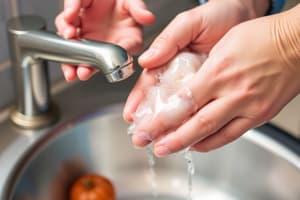Podcast
Questions and Answers
Where should a food thermometer be placed to measure the internal temperature of cooked meat?
Where should a food thermometer be placed to measure the internal temperature of cooked meat?
- In the center of the food
- In the thickest part of the food, avoiding bone, fat, or gristle (correct)
- Next to the bone of the meat
- Near the surface of the food
Why is it important not to thaw frozen food at room temperature?
Why is it important not to thaw frozen food at room temperature?
- Thawing at room temperature affects the taste of the food
- It can cause the food to lose its nutritional value
- It can lead to food poisoning
- Microorganisms can multiply quickly at room temperature (correct)
What is the recommended temperature for cooking food to ensure its safety?
What is the recommended temperature for cooking food to ensure its safety?
- 50˚C
- 60˚C
- 70˚C (correct)
- 80˚C
What is the recommended temperature for keeping food piping hot before serving?
What is the recommended temperature for keeping food piping hot before serving?
Why is it important to clean the food thermometer with hot, soapy water before and after each use?
Why is it important to clean the food thermometer with hot, soapy water before and after each use?
Older adults are not at higher risk for malnutrition
Older adults are not at higher risk for malnutrition
Malnutrition may impact cognitive and physical functioning
Malnutrition may impact cognitive and physical functioning
Screening and assessment of malnutrition among older adults is not an important health priority
Screening and assessment of malnutrition among older adults is not an important health priority
Flashcards are hidden until you start studying
Study Notes
Food Safety and Handling
- A food thermometer should be placed in the thickest part of the cooked meat, avoiding any fat, bone, or gristle, to accurately measure the internal temperature.
- Frozen food should not be thawed at room temperature to prevent bacterial growth and contamination.
- Cooked food should be heated to a minimum internal temperature of 165°F (74°C) to ensure food safety.
- Hot food should be kept at a minimum temperature of 145°F (63°C) before serving to prevent bacterial growth.
Malnutrition in Older Adults
- Malnutrition can have a significant impact on both cognitive and physical functioning in older adults.
- Screening and assessment of malnutrition among older adults are important health priorities due to the potential risks and consequences.
Studying That Suits You
Use AI to generate personalized quizzes and flashcards to suit your learning preferences.




